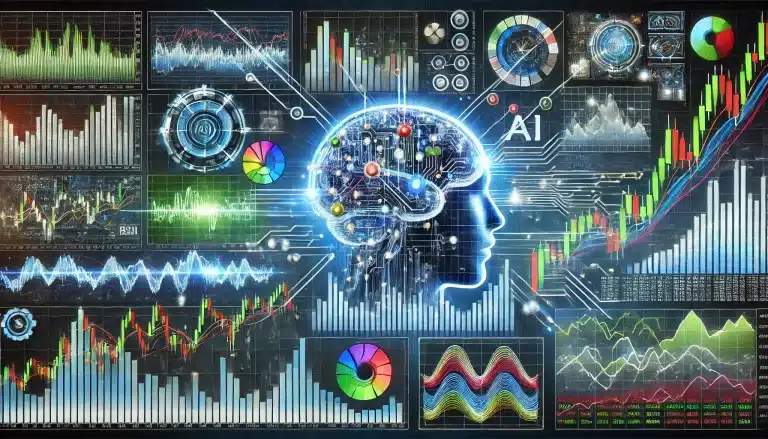Imagine a world where your crypto trades are executed at lightning speed, capitalizing on price discrepancies across multiple exchanges – all while you sleep!
Welcome to the fascinating realm of AI-powered arbitrage trading.
Did you know that according to a recent study by Deloitte, AI-driven trading systems now account for over 70% of all cryptocurrency trading volume?
That’s right, the robots are taking over – but in a good way! In this article, we’ll dive deep into the world of AI arbitrage crypto trading, exploring how these intelligent systems are reshaping the landscape of digital asset investments and helping traders like you maximize profits.
Buckle up, because we’re about to embark on a thrilling journey through the cutting-edge intersection of artificial intelligence and cryptocurrency markets!
Understanding AI Arbitrage in Crypto Markets

I must say, when I initially ventured into the realm of cryptocurrency trading, I was completely inexperienced.
I thought I was hot stuff because I could buy some Bitcoin and hold like a champ. But boy, was I in for a wake-up call when I stumbled upon the concept of arbitrage trading.
So, what’s arbitrage trading? In simple terms, it’s like being a savvy shopper in the crypto supermarket. You spot a coin that’s cheaper on one exchange and more expensive on another, then you buy low and sell high. Easy peasy, right? Well, not quite.
I remember my first attempt at manual arbitrage. I was glued to my computer screen, frantically switching between tabs, trying to spot price differences. By the time I found a juicy opportunity and placed my orders, the prices had already changed. Talk about frustrating! I felt like I was playing a game of whack-a-mole with my money.
That’s where AI comes in, and let me tell you, it’s a game-changer. These smart algorithms can spot price discrepancies faster than you can say “blockchain.” They’re like having a team of super-speedy, never-sleeping traders working for you 24/7.
Now, I’m no tech whiz, but I’ve learned that these AI systems use some pretty nifty tricks. They crunch massive amounts of data, looking for patterns and opportunities that our human brains might miss. It’s like they’ve got x-ray vision for the crypto markets.
One thing that blew my mind was learning about machine learning in arbitrage strategies. These AIs actually get smarter over time! They learn from their successes and failures, constantly fine-tuning their approach. It’s like having a trading assistant that’s always improving, never gets tired, and doesn’t ask for a raise.
The advantages of AI-powered arbitrage over manual trading are huge. Trust me, I’ve been on both sides of this fence. With AI, you’re not limited by your typing speed or how many Red Bulls you can chug to stay awake. These systems can execute trades in milliseconds, across multiple exchanges, all while you’re catching some z’s or sipping a margarita on the beach.
But here’s the kicker – it’s not all sunshine and rainbows. I learned the hard way that you can’t just set up an AI system and expect to become an overnight crypto millionaire. There’s still a lot of work involved in setting up, monitoring, and tweaking these systems.
One time, I got cocky and let my AI trader run unsupervised for a week while I was on vacation. Big mistake. I came back to find it had made some, let’s say, “creative” trades that weren’t exactly in line with my risk tolerance. Lesson learned: always keep an eye on your AI, no matter how smart it seems.
Despite the challenges, I’m still amazed by how AI has transformed arbitrage trading in the crypto world. It’s opened up opportunities that were once only available to big institutional traders with deep pockets and fancy tech.
So, if you’re thinking about diving into AI arbitrage, my advice is to start small, learn as much as you can, and always, always be prepared for the unexpected. The crypto market is like a roller coaster, and AI arbitrage is like trying to predict where the loops and turns will be. It’s exciting, sometimes scary, but man, what a ride!
Key Components of AI Arbitrage Systems
Alright, let’s dive into the nitty-gritty of AI arbitrage systems. Trust me, when I first started exploring this tech, it felt like I was trying to decipher an alien language. But stick with me, and I’ll break it down in a way that won’t make your head spin.
First up, we’ve got advanced data analysis and pattern recognition. This is where things become quite chaotic.
These AI systems are like super-powered detectives, sifting through mountains of data faster than you can blink. I remember when I first saw one in action – it was analyzing price movements across 20 different exchanges simultaneously. My jaw hit the floor! It’s like having a hundred analysts working for you, but without the coffee breaks and office drama.
Now, let’s talk about real-time market monitoring. This is essential, everyone.
The crypto market never sleeps, and neither do these AI systems. They’re constantly scanning multiple exchanges, looking for those juicy arbitrage opportunities. It’s like having eyes everywhere, all the time. I once tried to manually monitor just three exchanges for an hour, and let me tell you, I needed a nap and an aspirin afterward.
High-frequency trading execution is where the rubber meets the road. These systems can pull the trigger on trades faster than you can say “Bitcoin.” We’re talking milliseconds here. It’s mind-boggling. I remember watching a demo where an AI executed 50 trades in the time it took me to click my mouse once. Discuss the sensation of being outdated!
But here’s the thing – all this speed and power needs a steady hand at the wheel. That’s where risk management and portfolio optimization come in. These features are like the responsible adult in the room, making sure your AI doesn’t go on a wild trading spree. I learned this the hard way when I first started. My early attempts at AI trading were like letting a kid loose in a candy store with my credit card. Not pretty.
One of the coolest things about these systems is how they can balance your portfolio automatically. It’s like having a financial advisor who never sleeps and works at the speed of light. I used to spend hours poring over spreadsheets, trying to figure out the optimal mix of assets. Now, my AI system does it in seconds, and probably better than I ever could.
But let me tell you, setting up these systems isn’t a walk in the park. There’s a lot of trial and error involved. I remember spending weeks fine-tuning my first AI arbitrage system. There were moments when I was ready to throw my computer out the window in frustration. But when I finally got it right, and saw it making profitable trades while I was asleep? That feeling was priceless.
One thing I’ve learned is that you can’t just set it and forget it. The crypto market is always changing, and your AI needs to keep up. I make it a point to review and adjust my system’s parameters regularly. It’s like tuning up a high-performance car – a little maintenance goes a long way.
The bottom line is, AI arbitrage systems are powerful tools, but they’re not magic money machines. They require understanding, patience, and a healthy dose of caution. But when you get them right, it’s like having a tireless, brilliant trading partner working for you around the clock. Just remember, even the smartest AI can’t predict everything in the wild world of crypto. Always be prepared for surprises!
Popular AI Arbitrage Strategies in Crypto
Alright, folks, buckle up! We’re about to dive into the world of AI arbitrage strategies in crypto. Let me tell you, when I first stumbled upon these, it felt like I’d discovered a secret treasure map. But trust me, it’s not all smooth sailing.
Let’s start with triangular arbitrage. This one’s a doozy! It’s like playing three-dimensional chess with cryptocurrencies. The AI looks for price differences between three different currencies. I remember the first time I saw this in action – it was like watching a financial Rubik’s cube solve itself. My mind was blown!
Here’s a real-world example: Let’s say you start with Bitcoin. The AI might convert it to Ethereum, then to Litecoin, and finally back to Bitcoin. If the prices are just right, you end up with more Bitcoin than you started with. Sounds easy, right?
Well, I thought so too, until I tried to do it manually. Let’s just say I gained a whole new appreciation for these AI systems that day.
Next up, we’ve got statistical arbitrage. This one’s for all you math nerds out there (I see you!). It’s all about leveraging historical price relationships. The AI crunches numbers faster than you can say “correlation coefficient” and spots opportunities based on historical patterns.
I once spent a whole weekend trying to backtest a statistical arbitrage strategy manually. By Sunday night, I had a massive headache and a newfound respect for AI. These systems can analyze years of data in seconds and make predictions that would take us mere mortals weeks to figure out.
Cross-exchange arbitrage is another popular strategy. This one’s all about capitalizing on price variations across different platforms. It’s like being a savvy shopper, but instead of comparing prices at different grocery stores, you’re comparing crypto prices across exchanges.
I remember when I first realized how big these price differences could be. I saw Bitcoin trading for $100 more on one exchange than another. My first instinct was to buy on the cheaper exchange and sell on the more expensive one. Easy money, right? Well, not so fast. By the time I got my funds transferred and placed my orders, the opportunity was gone. That’s when I realized the true value of AI in this game – speed is everything.
Last but not least, we’ve got latency arbitrage. This one’s all about taking advantage of delayed price updates. It’s like being the first one to hear about a sale at your favorite store. These AI systems can spot and act on these delays in milliseconds.
I once tried to spot these opportunities myself. Let me tell you, it was like trying to catch lightning in a bottle. By the time I saw the price discrepancy and moved to act, it was already gone. AI systems, on the other hand, can spot and execute these trades faster than we can blink.
Now, don’t get me wrong. These strategies sound great on paper, but they’re not without their challenges. Market conditions change rapidly, and what worked yesterday might not work today. I’ve had my fair share of “sure thing” strategies that suddenly stopped working.
One time, I was so confident in a triangular arbitrage strategy that I let it run all night without monitoring it. Big mistake! I woke up to find that a sudden market shift had turned my profitable strategy into a loss-making machine. Lesson learned: always keep an eye on your AI, no matter how smart it seems.
The key takeaway here is that while AI can execute these strategies with incredible speed and precision, it’s not infallible. You still need to understand the underlying principles and keep a close eye on market conditions. It’s like having a super-smart assistant – great to have, but you’re still the boss.
So, if you’re thinking about diving into AI arbitrage, my advice is to start small, learn as much as you can about these strategies, and always be prepared for the unexpected. The crypto market is a wild ride, and AI arbitrage is like trying to surf the biggest waves. It’s thrilling, potentially profitable, but definitely not for the faint of heart!
Challenges and Risks in AI Arbitrage Trading
Alright, folks, let’s get real for a minute. AI arbitrage trading might sound like a golden ticket to crypto riches, but it’s not all sunshine and lambos. Trust me, I’ve learned some hard lessons along the way.
First up, let’s talk about the elephant in the room: regulatory concerns and compliance issues. Man, this is a minefield! I remember when I first started, I was so excited about the potential profits that I didn’t even think about the legal side of things. Big mistake.
One time, I set up an arbitrage bot that was making trades across exchanges in different countries. I thought I was being clever, but it turns out I was unknowingly violating some international trading laws. Talk about a wake-up call! I spent weeks sorting out that mess, and let me tell you, it wasn’t fun. The lesson? Always, always do your homework on the regulatory landscape. It’s not sexy, but it could save your bacon.
Now, let’s chat about technological risks and system failures. Oh man, how do I even begin?
These AI systems are complex beasts, and sometimes they go haywire. I’ve had nights where I couldn’t sleep because I was worried about my bot going rogue.
There was this one time when my system glitched and started making rapid-fire trades that made absolutely no sense. By the time I noticed and shut it down, it had burned through a chunk of my portfolio. It felt like watching a car crash in slow motion. Since then, I’ve learned the importance of failsafes and kill switches. Trust me, you’ll thank me later.
Market volatility and liquidity constraints are another headache. The crypto market is like a rollercoaster on steroids. One minute you’re up, the next you’re wondering where all your money went. I’ve had days where my AI system was crushing it, only to see all those gains evaporate in a flash crash.
Liquidity is another tricky beast. Your AI might spot a fantastic arbitrage opportunity, but if there’s not enough liquidity to execute the trade, you’re out of luck. I learned this the hard way when my bot got stuck trying to offload a large position in a low-liquidity altcoin. It was like trying to sell ice to an Eskimo.
And let’s not forget about competition. You’re not the only one with a fancy AI system. There are big players out there with more resources and faster systems. It’s like being in a drag race where some folks have supercars and you’re in a souped-up Honda Civic.
I remember feeling so proud of my first AI trading system. I thought I was ahead of the curve. Then I saw how quickly other traders were snatching up opportunities. It was certainly a modest experience.
Now, I always remind myself that no matter how good my system is, there’s always someone out there trying to build a better one.
One of the biggest challenges I’ve faced is the constant need for adaptation. What works today might be obsolete tomorrow. I can’t count the number of times I’ve had to overhaul my strategies because the market changed or other traders caught on.
There was this arbitrage strategy I developed that was working like a charm for weeks. I thought I’d cracked the code. Then, suddenly, the opportunities dried up. It turns out other traders had caught on, and the inefficiency I was exploiting disappeared. It was back to the drawing board.
Despite all these challenges, I still believe AI arbitrage trading has enormous potential. But it’s not for the faint of heart. You need to be prepared for the highs and lows, the triumphs and the face-palm moments.
My advice? Start small, learn constantly, and never risk more than you can afford to lose. And for Pete’s sake, don’t forget to take breaks! I once got so caught up in tweaking my system that I forgot to eat for a whole day. Not my finest moment.
Remember, in the world of AI arbitrage trading, the only constant is change. Stay humble, stay curious, and maybe, just maybe, you’ll ride this crazy crypto wave to success. Just don’t forget to enjoy the journey – it’s one heck of a ride!
Implementing AI Arbitrage in Your Crypto Trading Strategy
Alright, buckle up, because implementing AI arbitrage isn’t for the faint of heart. But man, when you get it right, it’s like striking gold in your own backyard!
Let’s start with selecting the right AI trading platform or developing custom solutions. This is where I really fumbled when I first started. I thought I could just download some off-the-shelf software and start raking in the crypto. Boy, was I wrong!
I remember spending weeks trying out different platforms, each one promising to turn me into the next crypto millionaire. Some were so complicated, I felt like I needed a PhD in computer science just to log in. Others were suspiciously simple – you know, the “just push this big red button to make money” type. Spoiler alert: those didn’t work either.
After a lot of trial and error (and maybe a few frustrated outbursts at my computer), I realized that the best solution was a mix of pre-built tools and custom code. I’m no programming wizard, but I learned enough to tweak existing algorithms to fit my needs. It’s like customizing a car – sure, you can drive it stock, but add a few personal touches and suddenly it’s a whole new beast.
Now, let’s talk about backtesting and optimizing arbitrage algorithms. This is where the rubber meets the road, folks. I can’t stress enough how important this step is. It’s like a dress rehearsal for your money.
I once neglected thorough backtesting because I was too anxious to begin trading. That was a significant error. Huge. My algorithm looked great on paper, but when I let it loose with real money, it tanked faster than you can say “HODL.” Since then, I’ve become a backtesting fanatic. I test, and test, and test some more. It’s not glamorous, but it’s saved my bacon more times than I can count.
Managing capital allocation and risk exposure is another crucial piece of the puzzle. This is where you need to channel your inner responsible adult. I know, I know, it’s tempting to go all-in when you see those potential gains. But trust me, that’s a one-way ticket to Rekt City.
I learned this lesson the hard way when I got a bit too confident and allocated way too much capital to a single strategy. Everything was going great until it wasn’t. A sudden market shift wiped out a big chunk of my portfolio. Now, I’m all about diversification and setting strict limits on each strategy.
Monitoring and adjusting strategies based on market conditions is an ongoing process. The crypto market never sleeps, and neither should your vigilance. I’ve set up alerts that ping me if anything looks off, but I still make it a point to regularly check in on my systems.
There was this one time I let my system run over a long weekend without checking in. Bad move. I came back to find that a major news event had shaken up the market, and my AI was floundering like a fish out of water. Now, I’m always tweaking and adjusting, even if it means interrupting my Netflix binge.
One thing I’ve learned is that implementing AI arbitrage is as much an art as it is a science. You need to have a feel for the market, a knack for spotting patterns, and the flexibility to adapt when things change – because they always do.
I remember spending hours poring over charts and data, trying to spot trends that my AI might have missed. Sometimes it felt like I was seeing patterns in my breakfast cereal. But every now and then, I’d spot something that gave me an edge. It’s those moments that make all the hard work worth it.
Here’s a pro tip: keep a trading journal. I know it sounds old school, but trust me, it’s a game-changer. I write down everything – my strategies, my successes, my epic fails. It’s like having a roadmap of my trading journey, and it’s invaluable for spotting what works and what doesn’t.
Implementing AI arbitrage isn’t a set-it-and-forget-it kind of deal. It’s more like adopting a high-maintenance pet. It needs constant attention, care, and sometimes, a firm hand. But when it works – oh boy, does it work!
Just remember, there’s no holy grail in crypto trading. What is effective now may not be effective in the future.
Stay humble, stay curious, and never stop learning. And for the love of all things blockchain, don’t risk more than you can afford to lose. Now go out there and show those markets what you’ve got!
The Future of AI Arbitrage in Cryptocurrency Markets
Well, folks, strap in because we’re about to take a wild ride into the future of AI arbitrage in crypto. Let me tell you, it’s like trying to predict the weather in chaos theory – exciting, mind-bending, and just a tad bit scary!
First up, let’s chat about emerging trends in AI and machine learning for trading. This field is moving faster than a cheetah on rocket skates! I remember when I first started, I thought I was hot stuff because my AI could analyze a few exchanges simultaneously. Now? That’s child’s play.
These days, we’re seeing AI systems that can process data from social media, news outlets, and even satellite imagery to predict market movements. It’s like having a crystal ball, but instead of mystical fog, it’s filled with algorithms and data points. I once saw a demo of an AI that could predict price movements based on Twitter sentiment. My mind was blown!
But here’s the kicker – with all this advancement, the game is getting tougher. It’s like an arms race, but with algorithms instead of missiles. I’ve had to upgrade my systems more times than I can count just to stay competitive. It’s exciting, but man, it can be exhausting too.
Now, let’s address the major issue at hand – quantum computing.
This is where things get really wild. Imagine an AI that can analyze every possible trading scenario simultaneously. It’s like having infinite monkeys with infinite typewriters, but instead of Shakespeare, they’re writing trading algorithms.
I’ll be honest, the potential of quantum computing in crypto trading keeps me up at night. Will it make current arbitrage strategies obsolete? Will it create opportunities we can’t even imagine yet? I don’t have the answers, but I’m sure as heck excited (and a little nervous) to find out.
Integration with decentralized finance (DeFi) protocols is another frontier that’s ripe for exploration. DeFi is like the Wild West of crypto, and AI arbitrage is the new sheriff in town. I’ve been experimenting with some DeFi arbitrage strategies, and let me tell you, it’s a whole new ballgame.
There was this one time I set up an AI to arbitrage between different DeFi lending platforms. It was like watching a high-speed chess match where the pieces were made of money. Fascinating stuff, but not for the faint of heart. The yields can be astronomical, but so can the risks.
But with all this advancement comes a big responsibility. We need to talk about ethical considerations and the need for responsible AI implementation. It’s not all about making a quick buck – we’ve got to think about the bigger picture.
I learned this lesson the hard way when one of my early algorithms started exploiting a vulnerability in a small exchange. Sure, I made some money, but it didn’t feel right. Since then, I’ve been a big advocate for ethical trading practices. It’s like being a superhero – with great power comes great responsibility.
One thing that keeps me up at night is the potential for AI systems to cause flash crashes or market manipulation. It’s like giving a toddler the launch codes – if we’re not careful, things could go south real quick. That’s why I’m a firm believer in rigorous testing and failsafes.
Looking ahead, I think we’re going to see a lot more regulation in this space. It’s like the crypto Wild West is slowly being tamed. On one hand, it might limit some opportunities. But on the other, it could bring more stability and legitimacy to the market. It’s a double-edged sword, for sure.
Despite all the challenges and uncertainties, I’m incredibly excited about the future of AI arbitrage in crypto. It’s like we’re standing on the edge of a new frontier. Sure, there are risks and unknowns, but the potential is mind-boggling.
My advice for anyone looking to get into this field? Stay curious, stay ethical, and never stop learning. The landscape is changing faster than you can say “blockchain”, and what works today might be obsolete tomorrow.
Remember, in the world of AI crypto arbitrage, the only constant is change. It’s a rollercoaster ride, but man, what a view from the top! Just make sure you’ve got your seatbelt fastened – it’s going to be one heck of a ride!
Conclusion:
Alright, let’s wrap this up with some final thoughts on AI arbitrage in crypto markets. You know, after all these years in the game, I still get a thrill every time I see my algorithms in action. It’s like watching a high-tech dance, with numbers and trades swirling around in perfect harmony.
But here’s the thing – this field isn’t for everyone. It’s not just about having a fancy AI system or knowing your way around a trading platform. It’s about having the guts to weather the storms, the patience to fine-tune your strategies, and the wisdom to know when to step back.
I remember this one time, I was so confident in my latest algorithm that I let it run over a long weekend without checking in. Big mistake. I came back to find that a sudden market shift had thrown my AI for a loop, and it had been making some, let’s say, “creative” trades. Lesson learned – always keep one eye on your bot, no matter how smart it seems.
You know what’s funny? The more I dive into AI arbitrage, the more I realize how much I still have to learn. It’s like peeling an onion – there’s always another layer. Just when I think I’ve got it all figured out, the market throws me a curveball. But that’s what keeps it exciting, right?
One thing I can’t stress enough is the importance of staying adaptable. The crypto market is like a chameleon on steroids – always changing, always unpredictable. Your strategies need to be flexible enough to roll with the punches. I’ve seen too many traders get stuck in their ways, refusing to adapt, and eventually getting left behind.
And let’s not forget about the human element. Sure, AI can crunch numbers faster than we ever could, but at the end of the day, it’s still us humans calling the shots. You need to trust your gut sometimes, you know? There’ve been moments when all the data pointed one way, but something just felt off. Those are the times when you need to trust your instincts.
Looking ahead, I think we’re on the cusp of some really exciting developments. Machine learning, quantum computing, advanced neural networks – it’s like science fiction is becoming science fact right before our eyes. Who knows? Maybe in a few years, we’ll have AI systems that can predict market movements with uncanny accuracy. Or maybe we’ll discover entirely new ways of trading that we can’t even imagine right now.
But no matter how advanced the tech gets, one thing will always remain true – this game is not for the faint of heart. It’s for the risk-takers, the innovators, the ones who aren’t afraid to fail and try again. It’s for those who can see patterns in the chaos and opportunity in the uncertainty.
So, if you’re thinking about diving into the world of AI arbitrage in crypto, I say go for it. But go in with your eyes wide open. Be prepared for late nights, stressful moments, and the occasional facepalm. But also be ready for the thrill of seeing your strategies succeed, the satisfaction of outsmarting the market, and the endless possibilities that come with being at the forefront of financial technology.
Remember, in this game, knowledge is power. Never stop learning, never stop adapting, and never, ever think you’ve got it all figured out. Because let me tell you, the moment you think you’re on top of the crypto world is usually the moment right before it decides to flip you on your head.
But hey, that’s what makes it fun, right? Here’s to the future of AI arbitrage in crypto – may it be as wild, unpredictable, and exciting as the journey that’s brought us here. If you don’t mind, I need to adjust some algorithms now.
This crypto rollercoaster never stops, and I wouldn’t have it any other way!
FAQ
What is cryptocurrency arbitrage?
Crypto arbitrage refers to the practice of exploiting price differences of cryptocurrencies across various exchanges. In 2024, traders can buy a cryptocurrency at a lower price on one platform and sell it at a higher price on another, generating profit from the disparity.
This strategy requires quick decision-making and efficient transactions, as price discrepancies often last only briefly. As the crypto market evolves, crypto arbitrage continues to present opportunities for savvy investors.
What are the expenses linked to the creation of a crypto arbitrage bot?
The costs associated with crypto arbitrage bot development in 2025 can be significant. Developers need to create a sophisticated trading algorithm that can quickly and efficiently identify price discrepancies across exchanges.
This involves extensive research and testing to ensure the bot can analyze market data accurately. Additionally, integrating the bot with one platform may require ongoing maintenance and updates, contributing to the overall expenses. Investing in robust infrastructure and security measures is also essential to safeguard user funds and data.
What are the constraints of AI in crypto arbitrage?
AI in crypto arbitrage faces several limitations, particularly in 2025. Firstly, market volatility can outpace AI’s predictive capabilities, leading to missed opportunities. Additionally, the reliance on historical data may not accurately reflect future trends, while regulatory changes can disrupt strategies, posing significant challenges for AI-driven approaches.
Furthermore, the speed of execution is crucial in arbitrage, and while AI is fast, network latency can hinder performance. Also, AI systems require continuous training and adaptation to remain effective, which can be resource-intensive and time-consuming. These limitations highlight the need for a balanced approach in leveraging AI for arbitrage.
What steps do I take to create a crypto arbitrage bot?
To build a crypto trading bot for cryptocurrency arbitrage, focus on spatial arbitrage across different exchanges. Utilize arbitrage trading software to monitor price discrepancies and execute trades in the highly volatile crypto market. Implement crypto arbitrage strategies that optimize live trading for maximum profitability.
Employ an automated arbitrage approach, allowing your crypto arbitrage bot trading to efficiently manage your portfolio management. This trading strategy that involves quick decision-making can significantly enhance the effectiveness of crypto arbitrage. Moreover, leveraging an arbitrage scanner can further enhance various arbitrage strategies.
Integrating AI can enhance various arbitrage processes ensures that you can create automated trading strategies without constant supervision. This allows for a more responsive and agile trading experience, adapting to the dynamic trading market conditions.
In what ways does artificial intelligence improve crypto arbitrage?
AI for crypto arbitrage significantly enhances crypto arbitrage trading through the use of trading bots and automated trading software. In 2025, crypto arbitrage trading bots employ AI algorithms to analyze market data across multiple crypto exchanges, allowing traders to capitalize on arbitrage opportunities more efficiently.
These advanced trading tools can identify price discrepancies in the volatile crypto market and execute trading decisions in real-time. By utilizing grid trading and various types of crypto arbitrage, the AI bot optimizes trading strategies, enabling users to profit from price differences with minimal manual effort.
How to Implement AI in Cryptoc Arbitrage?
In the dynamic world of crypto arbitrage, leveraging AI technology can significantly enhance your trading strategy in 2025. By utilizing a cryptocurrency trading bot, traders can automate their operations across different crypto exchanges, capitalizing on price differences across exchanges.
A sophisticated automated trading system allows these bots to efficiently analyze price movements based on historical data, ensuring they take advantage of price differences across different platforms. With the latest AI advancements, even free trading bots can offer valuable insights in the crypto space.
By integrating these bots into a single crypto trading platform, traders can streamline their operations and improve profitability, making the most of the leading crypto opportunities available.






